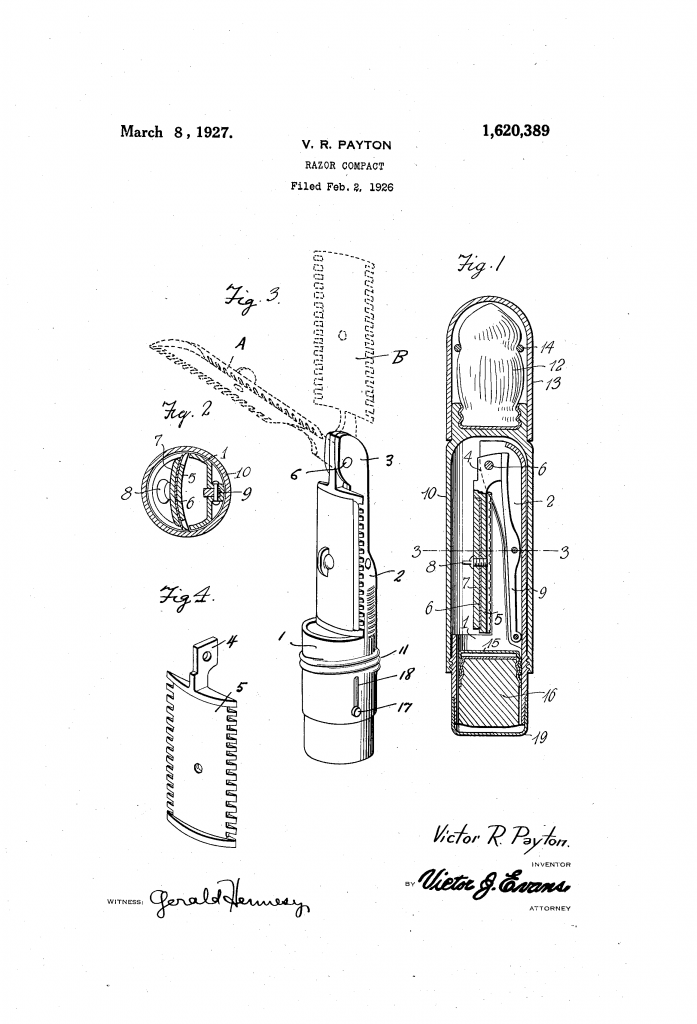Compact is a funny word, when you think about it. It can mean something dense, or densely packed. It can mean exerting a force on something to make it more, well, compact. Or it can be used to describe something that is a small and conveniently shaped example of its kind, such as a compact camera. I have seen it used to describe make up kits that fit in a purse. Or, in the case of Victor R Payton’s 1926 patent filing, a compact razor that fits in a pocket.
The desire for a compact razor
Filed in early 1926 and granted a little over a year later, the compact razor can more properly be described as a compact shaving kit. Thus it fits in nicely with other compact kits I’ve looked at lately, such as the pen style shavette from 1921, the combination writing instrument and shaver’s kit from 1936, and of course Bowlin’s shaving kit from 1947.
Similarly to those three, it is described as being in a form factor similar to a fountain pen. I mean, thicker and stubbier than most pens I’ve seen, but still. It is obvious that making something pen sized and shaped was a powerful motivator in the inter-war era. In hindsight one have to wonder why, since getting everything to fit in a small tube meant that compromises had to be made. And in some of the patents filed, the compromised makes it less than useful. Not so much with Payton’s compact razor though.
The patent

Again, the patent is an exercise in dense packaging. The compact package takes the form of a tube, with a lid on either end. On one end was a small stick of soap, on the other was a small brush. And in the middle was a hybrid of a regular safety razor and a shavette. The open comb razor head could be swung out 90° to use as a regular razor. Or the shaver could swing it to 180° to be used as a shavette.
The handle for the brush formed the protective cover over the razor. And while the patent don’t say it outright, I suspect that the brush handle could be reversed and used as a razor handle too.
How to use the compact razor
For a description on how to use the razor, let me quote the patent text:
By removing the caps 13 and 19 and projecting the soap 16, lather can be applied to the face in the usual manner and then the cap 10 is removed and the blade supporting member swung outwardly to shaving position. Then the face can be shaved and if it is desired to shave the neck, the supporting member is moved to a straight position, as shown at B in Figure 3 and the neck shaved. After shaving, the set screw 8 is removed to dissemble the blade holding means so that the parts can be cleaned and then the parts are replaced and the blade holder swung into its closed position, as shown in Figure 1. The caps are then put back and then the device may be replaced in the pocket.
From US patent 1,620,389
Sounds fairly straight forward and easy. Although I suspect the process would also include squeezing water out of the bristles before putting it away.
Thoughts on the compact razor
Abandoning the slimness of a pen means that Payton’s compact razor could use standard Gillette blades. This certainly makes it more appealing than a slimmer razor requiring specialised blades that you may or may not be able to replace. It also means that the brush could be wider and more useful than the thin ones found in other similar kit’s I’ve discussed in the past.
Overall… yes, I can see this setup for a travel razor. Small and discrete, it could easily fit in the carry on luggage when flying. If you were allowed to bring proper safety razors in your carry on, that is…
As usual, the full patent can be read at Google Patents. If you enjoy reading about old razor and shaving related patents, why not check out my latest book on the subject? Currently available for Kindle, as paperback, and even as a hardcover.
